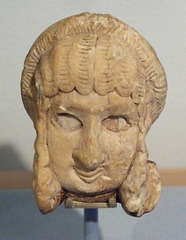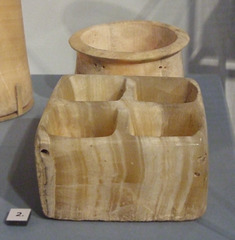
University of Pennsylvania Museum
The University of Pennsylvania Museum of Archeology and Anthropology, commonly called The University Museum, is an archaeology and anthropology museum that is part of the University of Pennsylvania in University City, Philadelphia, Pennsylvania. Text excerpted from: en.wikipedia.org/wiki/University_of_Pennsylvania_Museum_o...
Reconstruction Drawing of the Ishtar Temple at Ash…
| |
|
Peg with a Human-Faced Bull Protome in the Univers…
| |
|
Peg with a Human-Faced Bull Protome
Alabaster
2600-2350 BCE
Khafaje, Iraq
# 38-10-55
Text from the U. Penn. Museum label.
Peg with a Human-Faced Bull Protome in the Univers…
| |
|
Peg with a Human-Faced Bull Protome
Alabaster
2600-2350 BCE
Khafaje, Iraq
# 38-10-55
Text from the U. Penn. Museum label.
Sumerian Female Statue Fragment in the University…
| |
|
Statue Fragment (female)
Alabaster
2600-2350 BCE
Khafaje, Iraq
# 38-10-51
Text from the U. Penn. Museum label.
Sumerian Male Statue in the University of Pennsylv…
| |
|
Statue (Male)
Limestone
2600-2350 BCE
Khafaje, Iraq
# 37-15-29
Text from the U. Penn. Museum label.
Sumerian Statue of a Man in the University of Penn…
| |
|
Statue (Male)
Alabaster, Shell, and Lapis Lazuli
2600-2350 BCE
Khafaje, Iraq
# 37-15-31
Text from the U. Penn. Museum label.
Alabaster Statue from Khafaje in the University of…
| |
|
Statue
Alabaster
2600-2350 BCE
Khafaje, Iraq
# 37-15-35
Text from the U. Penn. Museum label.
Sumerian Alabaster Cosmetic Box in the University…
| |
|
Cosmetic Box
Alabaster
2550-2450 BCE
Ur, Iraq (PG1100)
# 30-12-697
Text from the U. Penn. Museum label.
Sumerian Lyre Inlay in the University of Pennsylva…
| |
|
Lyre Inlay
Shell
2550-2450 BC
Ur, Iraq (PG 1332)
#30-12-484
Text from the U. Penn. Museum label.
Sumerian Gold Earrings in the University of Pennsy…
| |
|
|
(top) Earring
Gold
2550-2450 BCE
Ur, Iraq (PG 1237)
# 30-12-442 A
and (bottom) Earring
Gold
2550-2450 BCE
Ur, Iraq (PG 1237)
# 30-12-442 B
Gold
Gold would have been imported from Anatolia, Iran, and the Indus valley. At Ur, golden objects are almost always made of alloys of gold and coppper or gold and silver. Pure gold is extremely rare. This is probably both because gold was a scarce and precious commodity, and because the color and appearance of the alloys was preferred. Gold and copper alloy is reddish, whild gold and silver (electrum) is silvery.
Text from the U. Penn. Museum label.
Sumerian Choker in the University of Pennsylvania…
| |
|
Choker
Gold and lapis lazuli
2550-2450 BCE
Ur, Iraq (PG1237, Body No. 16)
# 30-12-706
Text from the U. Penn. Museum label.
Gold
Gold would have been imported from Anatolia, Iran, and the Indus valley. At Ur, golden objects are almost always made of alloys of gold and coppper or gold and silver. Pure gold is extremely rare. This is probably both because gold was a scarce and precious commodity, and because the color and appearance of the alloys was preferred. Gold and copper alloy is reddish, whild gold and silver (electrum) is silvery.
Text from the U. Penn. Museum label.
Sumerian Gold Wreath in the University of Pennsylv…
| |
|
|
Wreath
Gold, Lapis lazuli, and carnelian
2550-2450 BCE
Ur, Iraq (PG789)
# B16740
Text from the U. Penn. Museum label.
Gold
Gold would have been imported from Anatolia, Iran, and the Indus valley. At Ur, golden objects are almost always made of alloys of gold and coppper or gold and silver. Pure gold is extremely rare. This is probably both because gold was a scarce and precious commodity, and because the color and appearance of the alloys was preferred. Gold and copper alloy is reddish, whild gold and silver (electrum) is silvery.
Text from the U. Penn. Museum label.
Sumerian Vessel in the Form of an Ostreich Egg in…
| |
|
Vessel in the Form of an Ostreich Egg
Gold, lapis lazuli, red limestone, shell, and bitumen
2550-2450 BCE
Ur, Iraq (PG779)
B16692
Text from the U. Penn. Museum label.
Gold
Gold would have been imported from Anatolia, Iran, and the Indus valley. At Ur, golden objects are almost always made of alloys of gold and coppper or gold and silver. Pure gold is extremely rare. This is probably both because gold was a scarce and precious commodity, and because the color and appearance of the alloys was preferred. Gold and copper alloy is reddish, whild gold and silver (electrum) is silvery.
Text from the U. Penn. Museum label.
Sumerian Electrum Tumbler in the University of Pen…
| |
|
Tumbler
Electrum
2550-2450 BCE
Ur, Iraq, (PG800, Tomb Chamber)
# B17691
This drinking vessel has been hammered out of a single piece of electrum, an alloy of gold and silver. It most likely would have been used at a royal banquet. Although it is made out of a precious metal, its design and fluted shape are typical of Mesopotamian drinking vessels. Examples can be seen in representations on cylinder seals and lyre panels. The loop on the rim suggests that the tumbler may have been hung around the neck or looped around the wrist with string or wire.
Text from the U. Penn. Museum label
Sumerian Gold Cosmetic Container in the University…
| |
|
Cosmetic Container
Gold
2550-2450 BCE
Ur, Iraq (PG800)
# B16710
These gold containers were found in Queen Puabi's tomb chamber. The oval shape of the two bowls is a common metal vessel form. The fluted bowl shares many design elements with the fluted tumbler, and they may be thought of as a set. The cosmetic container, shaped as a cockleshell, was filled with a green pigment. The pieces are in such good condition because gold is a stable metal.
Text from two U. Penn. Museum labels.
Sumerian Gold Bowl in the University of Pennsylvan…
| |
|
|
Bowl
Gold
2550-2450 BCE
Ur, Iraq (PG800, Tomb Chamber)
B17693
These gold containers were found in Queen Puabi's tomb chamber. The oval shape of the two bowls is a common metal vessel form. The fluted bowl shares many design elements with the fluted tumbler, and they may be thought of as a set. The cosmetic container, shaped as a cockleshell, was filled with a green pigment. The pieces are in such good condition because gold is a stable metal.
Text from two U. Penn. Museum labels.
Gold
Gold would have been imported from Anatolia, Iran, and the Indus valley. At Ur, golden objects are almost always made of alloys of gold and coppper or gold and silver. Pure gold is extremely rare. This is probably both because gold was a scarce and precious commodity, and because the color and appearance of the alloys was preferred. Gold and copper alloy is reddish, whild gold and silver (electrum) is silvery.
Text from the U. Penn. Museum label.
Sumerian Gold Bowl in the University of Pennsylvan…
| |
|
|
Bowl
Gold
2550-2450 BCE
Ur, Iraq (PG800, Tomb Chamber)
B16707
These gold containers were found in Queen Puabi's tomb chamber. The oval shape of the two bowls is a common metal vessel form. The fluted bowl shares many design elements with the fluted tumbler, and they may be thought of as a set. The cosmetic container, shaped as a cockleshell, was filled with a green pigment. The pieces are in such good condition because gold is a stable metal.
Text from two U. Penn. Museum labels.
Gold
Gold would have been imported from Anatolia, Iran, and the Indus valley. At Ur, golden objects are almost always made of alloys of gold and coppper or gold and silver. Pure gold is extremely rare. This is probably both because gold was a scarce and precious commodity, and because the color and appearance of the alloys was preferred. Gold and copper alloy is reddish, whild gold and silver (electrum) is silvery.
Text from the U. Penn. Museum label.
Silver Spouted Jug in the University of Pennsylvan…
| |
|
Spouted Jug
Silver
2550-2450 BCE
Ur, Iraq (PG 800, Tomb Chamber)
# B17082B
Text from the U. Penn Museum label.
Jump to top
RSS feed- Latest items - Subscribe to the latest items added to this album
- ipernity © 2007-2025
- Help & Contact
|
Club news
|
About ipernity
|
History |
ipernity Club & Prices |
Guide of good conduct
Donate | Group guidelines | Privacy policy | Terms of use | Statutes | In memoria -
Facebook
X


















